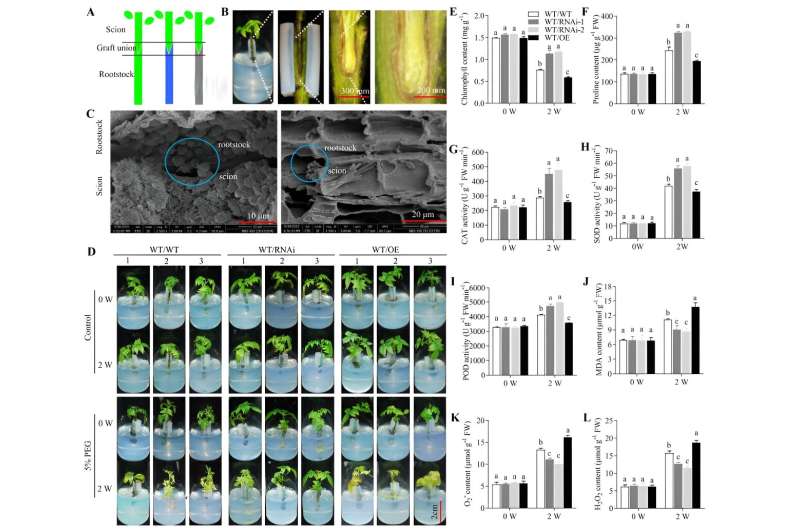This article has been reviewed according to Science X's editorial process and policies. Editors have highlighted the following attributes while ensuring the content's credibility:
fact-checked
peer-reviewed publication
proofread
How engineered walnuts combat drought through grafting

Drought is a major threat to walnut production globally, often resulting in lower yields and weaker trees. While grafting has traditionally been used to improve the resilience of fruit and nut trees, the exact mechanisms of signal transfer between rootstocks and scions have remained elusive. Given these challenges, there is a pressing need to explore how genetic modifications in rootstocks can be leveraged to enhance drought tolerance in walnut trees.
Researchers at Zhejiang A&F University have published a study in Horticulture Research on May 24, 2024, investigating how genetically altered rootstocks affect drought responses in grafted walnut trees. The research focused on the JrGA20ox1 gene, which plays a key role in gibberellin production, examining how its overexpression or suppression in rootstocks influences scion performance under drought. This study sheds light on the potential of using rootstock modifications to develop more drought-resistant tree varieties.
The study utilized an advanced grafting technique where wild-type walnut scions were grafted onto rootstocks genetically engineered to either overexpress or suppress the JrGA20ox1 gene. Under drought-like conditions, scions grafted onto JrGA20ox1-overexpressing rootstocks showed reduced drought tolerance, characterized by lower chlorophyll levels, increased leaf yellowing, and heightened oxidative stress.
Conversely, scions grafted onto rootstocks where JrGA20ox1 was suppressed displayed enhanced drought tolerance, retaining more chlorophyll, experiencing less oxidative stress, and reducing water loss. Further analysis identified that gibberellins, particularly GA4, were crucial in this rootstock-to-scion signaling, traveling from rootstock to scion and directly impacting the drought response.
Additionally, small RNAs from the JrGA20ox1-RNAi vector in the rootstocks were found to move into the scions, further downregulating JrGA20ox1 expression and bolstering drought tolerance. These results underscore the significant potential of gene manipulation in rootstocks to improve the drought resistance of grafted trees.
Senior researcher Dr. Qixiang Zhang highlighted the study's broader implications, saying, "This research provides crucial insights into how genetic modifications in rootstocks can be harnessed to improve drought tolerance in grafted trees. Our findings not only advance our understanding of rootstock-scion interactions but also pave the way for developing more resilient crop varieties in response to climate change. The ability to precisely control drought responses through rootstock gene expression could revolutionize tree breeding and agricultural practices."
The findings have profound implications for agriculture, especially in drought-prone regions. By genetically modifying rootstocks, farmers can increase their crops' resilience without altering the genetic makeup of the fruits. This approach also holds promise for application in other tree species, enabling the development of new drought-resistant cultivars. The study highlights the critical need for continued research into grafting technologies as a sustainable strategy for ensuring global food security.
More information: Heqiang Lou et al, JrGA20ox1-transformed rootstocks deliver drought response signals to wild-type scions in grafted walnut, Horticulture Research (2024). DOI: 10.1093/hr/uhae143
Journal information: Horticulture Research
Provided by Zhejiang A&F University



















